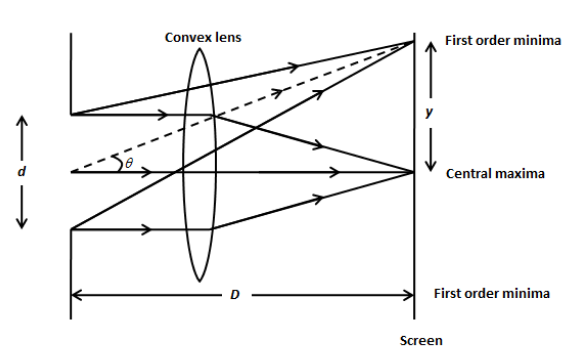
Draw a neat diagram of experimental arrangement of diffraction due to a single slit?
Answer
546.3k+ views
Hint: Recall Young’s single slit experiment for the diffraction pattern. Draw the diagram of Fresnel diffraction for finite distance of the slit and screen. Show the position of at least one maximum and one minimum on the screen.
Complete answer:
We know that due to diffraction, the waves passing through the narrow aperture tend to spread out. In a single slit diffraction pattern, a central maximum is about 6 times larger than the maxima on either side of the central maxima. Let us draw the experimental arrangement for the single slit diffraction pattern as shown in the figure below.

In the above figure, D is the distance between the screen and slit, d is the width of the slit and y is the position of the minima. We have the condition of the maxima of diffraction,
\[d\sin \theta = n\lambda \]
Here, n is the order of diffraction, d is the width of the slit and \[\lambda \] is the wavelength of the light used.
We can see the similar diffraction pattern on either side of the central maxima. The position of the minima from the central maxima is given as,
\[y = \lambda dD\]
Thus, we can express the width of the central maxima as,
\[\Delta y = 2\lambda Dd\]
The spectrum of the diffraction pattern appears broad if the width of the slit is a minimum. We see the diffraction pattern due to a series of constructive and destructive interference of light.
Note:For the diffraction to occur, the incident light should be monochromatic. Also, the slit width should be in order of wavelength of incident light. Note that, in a single slit, the intensity of the central maxima is comparably greater than the intensity of other order maxima.
Complete answer:
We know that due to diffraction, the waves passing through the narrow aperture tend to spread out. In a single slit diffraction pattern, a central maximum is about 6 times larger than the maxima on either side of the central maxima. Let us draw the experimental arrangement for the single slit diffraction pattern as shown in the figure below.

In the above figure, D is the distance between the screen and slit, d is the width of the slit and y is the position of the minima. We have the condition of the maxima of diffraction,
\[d\sin \theta = n\lambda \]
Here, n is the order of diffraction, d is the width of the slit and \[\lambda \] is the wavelength of the light used.
We can see the similar diffraction pattern on either side of the central maxima. The position of the minima from the central maxima is given as,
\[y = \lambda dD\]
Thus, we can express the width of the central maxima as,
\[\Delta y = 2\lambda Dd\]
The spectrum of the diffraction pattern appears broad if the width of the slit is a minimum. We see the diffraction pattern due to a series of constructive and destructive interference of light.
Note:For the diffraction to occur, the incident light should be monochromatic. Also, the slit width should be in order of wavelength of incident light. Note that, in a single slit, the intensity of the central maxima is comparably greater than the intensity of other order maxima.
Recently Updated Pages
Master Class 12 English: Engaging Questions & Answers for Success

Master Class 12 Business Studies: Engaging Questions & Answers for Success

Master Class 12 Economics: Engaging Questions & Answers for Success

Master Class 12 Social Science: Engaging Questions & Answers for Success

Master Class 12 Maths: Engaging Questions & Answers for Success

Master Class 12 Chemistry: Engaging Questions & Answers for Success

Trending doubts
What are the major means of transport Explain each class 12 social science CBSE

Which are the Top 10 Largest Countries of the World?

Draw a labelled sketch of the human eye class 12 physics CBSE

Explain sex determination in humans with line diag class 12 biology CBSE

Explain sex determination in humans with the help of class 12 biology CBSE

Differentiate between homogeneous and heterogeneous class 12 chemistry CBSE




